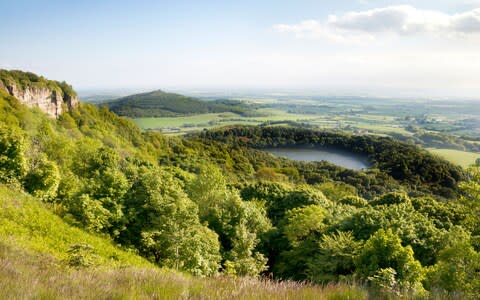Handsome towns, heather and 'the finest view in England': The Cleveland Way at 50

After a stiff climb up, I silently thanked Alec Falconer for his seat atop Cringle Moor. From the lofty memorial – reading “Rambler, 1884-1968” – the Cleveland Hills escarpment plunged 900-odd feet to the quilted-green vale below; on a less dour day, I might have seen all the way to Durham Cathedral. But I also thanked Alec for his vision: he first proposed a long-distance walk linking Yorkshire’s moors and coast in the Thirties. He died the year before it came to fruition.
The Cleveland Way, opened in May 1969, is now celebrating its 50th. The second of Britain’s National Trails, it’s a bit of an odd one, describing a jiggly, 80-mile (130km) upturned horseshoe between the moorland market town of Helmsley and seaside resort of Filey.
“The shape is about capturing the best possible experiences of both the inland and coastal sections of the North York Moors,” Malcolm Hodgson, national trails officer, told me. “The shape means the route often follows an escarpment, giving outstanding views both into and out beyond the national park.”
A trail of two halves, then, but thematically bound by its ancient name: Cleveland, or “cliff land” – as appropriate to the route’s North Sea-battered section, encompassing the highest cliffs on the east coast, as it is to the moorland leg, with its dramatic drop-offs such as from the Wainstones and Sutton Bank.
Having started my long-distance hike in handsome Helmsley, I’d traced Sutton Bank the previous day. It was there that I received my first Yorkshire “how do” from a fellow walker. And it was there that a craft landing at one the world’s oldest gliding clubs (where pioneering aviatrix Amy Johnson once flew) swooshed close enough to ruffle my hair.

The view from this near-vertical precipice – of the limestone scarp nosediving to the flat, green vales, of Norman castle-topped Hood Hill and mythically bottomless Gormire Lake – was the “finest in England” according to James Herriot.
It was impressive, though I preferred the next stretch, beyond the enormous cakes at Paradise Hills Farm, on to Sneck Yate. There were fewer people – it was mainly red grouse dashing daftly amid the heather and tumbling lapwings. I was following the old Hambleton Road, once used by Scottish drovers bringing livestock south; there used to be inns up here, but only a few ruins remain.
Unlike the trail, which was in tip-top condition. “There’s local pride in the Cleveland Way, demonstrated by the level of volunteering,” Malcolm told me. “A maintenance team turns out on a weekly basis, and every trail section (there are 26) has been ‘adopted’ by groups who monitor them, and report any issues.”

I was grateful for their efforts, especially as I hiked across the wilder stretches of the moors – bleakly beautiful or downright terrifying, depending on the weather. However, when the trail hit the coast at Saltburn, navigation became even simpler: turn right, keep the sea on your left, don’t stop until Filey, 50 miles (80km) away.
With a sea fret coming in, it was a dowly day as I climbed out of Saltburn. My soundtrack had now changed: gone were the grouse and pheasants; now it was screeching gulls, chattering field birds and crashing waves.
I paused in Staithes to buy a slab of apple-walnut coble cake from the Sea Drift Café; a little later I ate it, with the pot of cream I’d been given too, while looking down through the mist to the fossil-rich shore. And this was how the Cleveland Way’s coast unfurled: a succession of (mostly) pretty towns and (always) dramatic cliffs, wheeled by seabirds and rife with primroses, gorse and blackthorn blossom.

In Whitby I caught up with Captain James Cook, who trained here, and Dracula, who ran up the ruined abbey’s 199 steps – tours, museums and bad puns related to both men proliferate. Indeed, tourism has taken over; the town’s fishing fleet is tiny these days. But the bricks and mortar remain fascinating, from the grand Georgian captains’ houses to the knot of old sea-salty back-alleys.
I ate predictably excellent fish and chips by the harbour, and then had a drink at the White Horse & Griffin, where Cook and William Scoresby (inventor of the crow’s nest) used to hire their crews.

As luck would have it, the fret lifted for my last few days, allowing clear views of white waves and huge cliffs all the way to Filey. My legs were feeling the miles, but when the Cleveland Way was joined by the Coast to Coast Path’s finishing straight, it seemed unwise to complain – these walkers had come twice as far, and would be elated to be stopping in Robin Hood’s Bay.
However, that does mean they just missed my favourite part of the Cleveland Way. Having skirted the sweeping bay, hauled up to Ravenscar and edged Beast Cliff, I dropped into Hayburn Wyke, an unexpected little dell of trees twisting alongside a secretive inlet, with a waterfall splashing the beach. It was unlike the moors I’d traversed, the seashore I’d so far traced, or the coast – including Scarborough – still ahead. Another bite of variety on this selection-box of a trail.

How to do it
A 10-night self-guided Cleveland Way trip with Celtic Trails costs from £785pp including B&B accommodation, luggage transfers, route guides and maps (01291 689774; celtictrailswalkingholidays.co.uk). For more info see Trailblazer Cleveland Way (first edition, 2019; trailblazer-guides.com) and nationaltrail.co.uk/cleveland-way.

 Yahoo News
Yahoo News 
